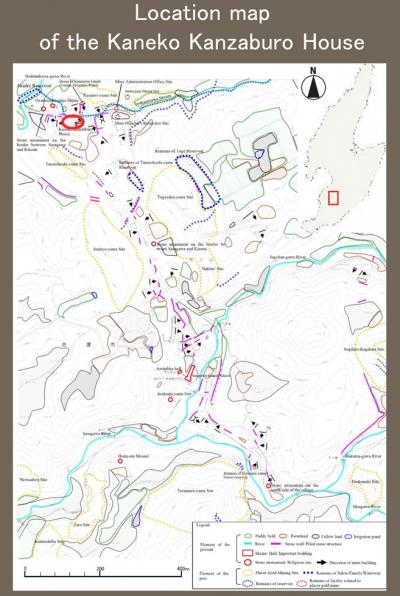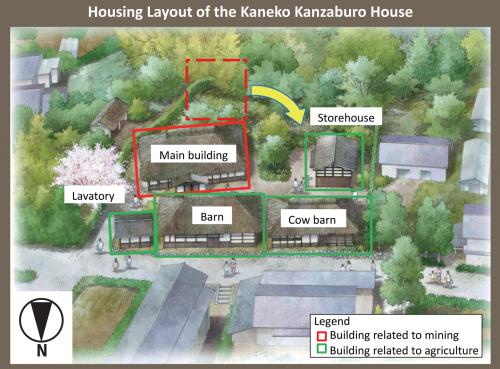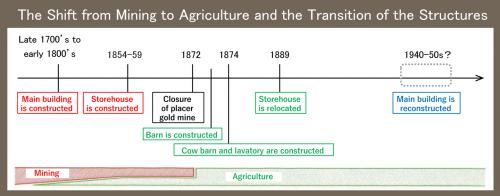本文
【金子勘三郎家】 パネル2(Part 2)
其の二 鉱業から農業への転換と敷地内建物の変遷
砂金山閉山に伴う生活・生業の変化
1872(明治5)年の閉山後、笹川集落では、周辺の空地・砂金採取跡地・堤跡地などの開墾や、大流し用の導水路を農業用水路に転用するなどして農地開発が行われました。また、新たに炭焼きや、タバコ・ゼンマイ・シイタケの栽培を始めるなど、鉱業から農業へと生活・生業の形態が大きく変化していきました。
これに伴い、各家では納屋や牛納屋など、農業に必要な建物が建築されていきます。佐渡の一般的な農家では、主屋を南向きとし、前庭の周囲に附属屋を建てます。しかし当集落では、主屋の向きや附属屋の配置が各家で異なっているという特徴がみられます。
これは、山あいの集落で平地が少ないことに加え、長年の砂金採取によって、起伏が多い地形となったことが要因であると考えられます。
このように当集落では、地理的環境に順応した土地利用が行われ、鉱業から農業への生活・生業の転換が図られていきました。
生活・生業の変化がもたらした金子家の建物の変遷
金子勘三郎家の敷地には、北側の前面道路に沿って西から牛納屋、納屋、便所の3棟が立ち並び、前庭を挟んで奥に主屋、土蔵が配置されています。
このうち最も古いとされる主屋は、1700年代後期から1800年代初期の建築と推測されます。次いで1854~59年(安政年間)に土蔵が建てられたと伝えられています。
また、砂金山閉山直後の1874(明治7)年に納屋と牛納屋、便所がほぼ同時に建築されたと推測されます。なお土蔵は、1889(明治22)年に主屋の裏手から現在地へ移築されており、生活・生業の変化に伴い、建物の新築や移築が行われていきました。
このように、当家では、江戸時代の砂金採取を生業とした時代の建物と、明治時代以降の農業を生業とした時代の建物が現存しており、生活・生業の変遷をうかがい知ることができます。
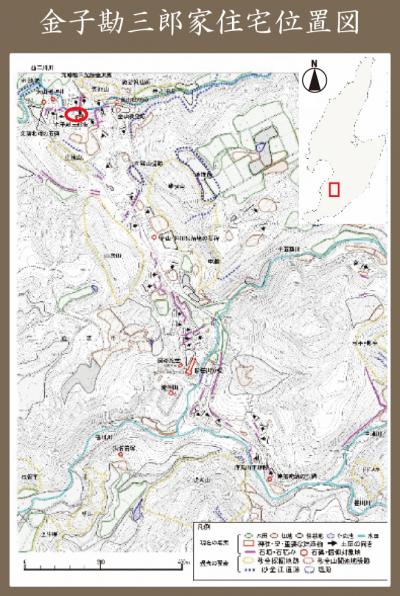
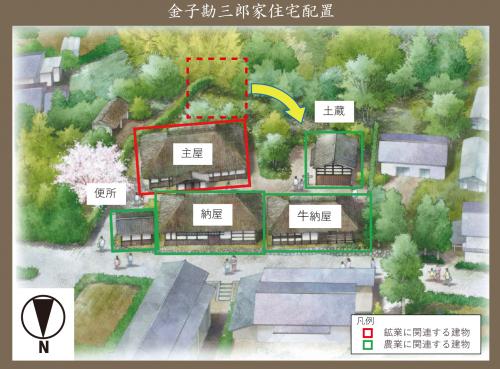

Part 2 The Shift from Mining to Agriculture and the Transition of the Structures on the Premises
Changes in the Lifestyles and Occupations Following the Closure of the Placer Gold Mine
After the closure of the mine in 1872, agricultural land was developed in the Sasagawa settlement through cultivating the surrounding vacant land in the former placer gold mining sites and reservoir sites, and through diverting waterways for “Onagashi” to agricultural waterways. Furthermore, some people started making charcoal and cultivating tobacco, Asian royal ferns and shiitake mushrooms, drastically shifting their lifestyles and occupations from mining to agriculture.
In accordance with this, each family constructed buildings necessary for farming such as sheds and cow barns. Ordinary farmers in Sado built their main building facing the south with annexes around the front yard. However, in this settlement, the orientation of the main building and the location of the annexes varied by household.
It is thought that these settlements were built as such because of the lack of flat land due to the mountainous location and the bumpy topography caused by the long history of placer gold mining.
In this way, the settlement adapted its land use to its geographical environment and the residents shifted their lifestyle and occupations from mining to agriculture.
Changes in the Buildings of the Kaneko Family Caused by the Shift in Lifestyles and Occupations
At the Kaneko Kanzaburo House site, a cow barn, a shed and a lavatory are located from the west along the front road on the northern side, and the main building and storehouse are located at the back beyond the front yard.
Among these, the main building, which is considered to be the oldest one, is presumed to have been built between the late 1700s and the early 1800s. The storehouse, which is thought to be the second oldest building, is said to have been built between 1854 and 1859.
The shed, cow barn and lavatory are presumed to have been built almost at the same time in 1874, right after the closure of the placer gold mine. The storehouse was relocated to its current location from behind the main building in 1889. These structures were newly built and relocated according to the shift in the residents’ lifestyles and occupations.
At the Kaneko Kanzaburo House, buildings from both the placer-gold mining Edo period and the agricultural Meiji period still exist, and these demonstrate the shift in the residents’ lifestyles and occupations.
